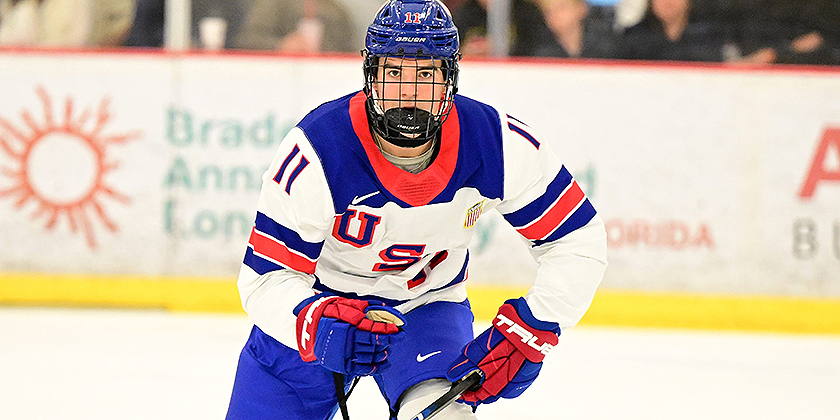
Cole McKinney (C, R, 6’0″, 200, NTDP U18, 03/16/2007, Michigan)
Cole McKinney is a reliable, two-way center with a sturdy frame and high-end hockey IQ. His consistent presence in all three zones and versatility as both a top power-play and penalty-kill option underscores the trust he’s earned from the U.S. National Team Development Program’s staff. While he’s not a flashy puck carrier or dynamic offensive driver, McKinney’s game is built on details, responsibility, and subtle execution. His skating is not elite, and he does most of his damage with quick decisions, body positioning, and puck protection. He finished the year with 55 points in 51 games, including 26 points in 23 USHL games, proving he can contribute against older competition.
Why Cole McKinney Should Be an NHL Draft Pick
1) Two-Way Reliability & Coach Trust
McKinney plays with maturity and purpose. His usage reflects this: 18:56 average TOI, 2:39 PPT, and 2:02 SHT per game. He wins trust through consistent reads, active stick positioning, and strong off-puck support in all three zones. He’s defensively responsible and can kill penalties at a high level by reading the play, pressuring with pace, and clearing with composure.
2) Offensive Touch & Playmaking IQ
McKinney processes well with the puck. He uses delays, vision, and deception to find seams, and his 29% scoring chance conversion rate on 1.48 scoring chances/game is indicative of his elite finishing ability. He posted 26 points in 23 USHL games, suggesting that his hockey sense allows his game to translate against tougher, older competition. His 0.64 pre-shot passes/game is modest for a first-unit power play guy, but his touch and instincts in space are real.
3) Faceoff Ability
At the U18 level, McKinney handled 17 draws per game at a 53% win rate, showing quick, strong hands and composure under pressure. He’s not dominant, but he’s reliable in key draws, especially in the defensive zone.
4) Forecheck Pressure & Puck Recovery
His compete level is strong. He averages 5.5 puck recoveries and 4.3 takeaways/game, often initiating turnovers with anticipation rather than brute force. He consistently tracks and pressures well on the forecheck and was often the player creating broken plays.
Why Cole McKinney Should Not Be an NHL Draft Pick
1) Lack of Physical Imposition
Despite a 6’0”, 200-lb frame, McKinney doesn’t consistently play through contact. He gives just 0.64 hits/game while absorbing 1.14 hits/game — a concerning disparity for a center with a strong base. His 49% battle win rate reflect his passiveness in contested scenarios and the tendency to force plays under pressure.
2) Shot Volume & Creation
McKinney needs to become a greater offensive threat. With 3.1 shots/game, just 2.2 on goal, and a low 0.64 pre-shot passes/game, he often looks to distribute rather than create for himself. He can finish in tight (29% scoring chance % is elite), but doesn’t generate much offense off the rush or with pace. He’ll need to find ways to create more shot volume at higher levels.
3) Puck Security
Though a smart distributor, McKinney averages over 5 puck losses/game and completes 84% of his passes. This is a result of trying to make high-end passes through traffic and occasionally skating himself into pressure. This could become an issue when pace and time are tighter at the next level.
Projection & Development Outlook
Player Projection: Bottom-six forward who contributes in all situations and provides strong special teams value.
Development Path: Likely 3 years in NCAA hockey with consistent top-6 usage and heavy special teams minutes, before transitioning to the AHL.
Draft Recommendation: 3rd–4th Round Target
Cole McKinney is a high-floor, medium-ceiling player with strong habits and a reliable 200-foot game. He won’t wow on tape, but he’s the type of player coaches lean on, especially late in games or during special teams sequences. His lack of elite skating and dynamic offensive skill will limit his ceiling, but his work rate, IQ, and versatility make him a valuable development piece. Teams looking to build depth down the middle with a high IQ player will see real value in drafting McKinney in the middle rounds.
Photo credit: Dan Hickling/Hickling Images
